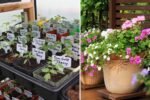Join on WhatsApp
Get the latest updates directly on WhatsApp – motivation, news & more!
Gardening doesn’t always have to be a long wait. While many vegetables take months to mature, some grow surprisingly fast perfect for those who want quick results or are just getting started with home gardening. Whether you’re planting in a backyard bed, balcony pot, or windowsill container, these speedy crops are ideal for anyone craving fresh produce in record time.
If you’re eager to grow your own food but don’t want to wait an entire season, this guide will introduce you to five vegetables that can be harvested in just about two weeks. Along the way, we’ll also share practical tips to help you get the most out of your quick-growing garden.
Why Fast-Growing Vegetables Are Worth It
Short-harvest crops are ideal for new gardeners, busy families, or anyone craving the satisfaction of growing food without the wait. These vegetables also make great “gap fillers” in a larger garden, allowing you to maximize your space and keep something growing at all times.
Additionally, many fast-growing vegetables are loaded with nutrients. They’re typically leafy greens or young shoots, meaning they’re rich in vitamins, minerals, and antioxidants. The best part? They taste great and can be used in salads, stir-fries, smoothies, and more.
Now, let’s take a look at five vegetables you can grow and enjoy in as little as 15 days.
Radish Sprouts
Radishes are already one of the fastest root vegetables around, but when you grow them as sprouts or microgreens, they’re ready in less than two weeks. The flavor is spicy and crisp, adding a peppery kick to sandwiches or salads.
To grow them, simply scatter radish seeds in a shallow tray filled with potting mix or use a sprouting jar. Water them lightly and keep them in a warm, bright spot. You’ll see growth in just a couple of days, and by day 10 to 12, the sprouts will be tall enough to harvest.
The key to success is to keep them moist but not waterlogged. Harvest using clean scissors, and you’ll have a fresh, crunchy garnish with almost no effort.
Lettuce Leaves
Leaf lettuce is one of the easiest vegetables to grow quickly. You don’t have to wait for a full head to form just pick the baby leaves as soon as they’re big enough to use. In around 12 to 15 days, you’ll have your first mini harvest.
Choose loose-leaf varieties like red oak, butter lettuce, or romaine. These are perfect for cut-and-come-again harvesting, meaning you can snip off outer leaves and allow the plant to continue growing.
Sow seeds directly in a pot or garden bed, water gently, and place in partial to full sun. Lettuce loves cooler conditions, so early morning or late afternoon sun works best if you’re gardening in hot climates.
Spinach
Spinach is another leafy green that grows fast and is packed with nutrients. Baby spinach leaves are ready to pick in just about 15 days when grown in ideal conditions. It grows best in cooler temperatures and partial sunlight.
Start by sowing seeds in well-drained, nutrient-rich soil. Keep the soil consistently moist, and you’ll see germination in just 5 to 7 days. As soon as the leaves are 2 to 3 inches long, they can be harvested for fresh salads or light sautéing.
The great thing about spinach is that you can continue harvesting young leaves over a few weeks, making it a productive and space-efficient choice.
Mustard Greens
If you like your greens with a bit of a bite, mustard greens are a great option. They’re among the quickest-growing leafy vegetables and can be ready for harvesting in 12 to 15 days as microgreens or baby leaves.
Sow them directly in containers or raised beds and keep the soil moist. These hardy greens sprout quickly and are happy in both sunny and partially shaded areas. Mustard greens are rich in antioxidants and provide a distinct flavor to soups, stews, and stir-fries.
Once the young leaves reach 3 to 4 inches in height, snip them off gently, and the plant will continue producing more.
Fenugreek (Methi)
Fenugreek, commonly known as methi, is widely used in South Asian cooking and is incredibly easy to grow from seed. As microgreens or young leaves, fenugreek can be harvested in 10 to 15 days.
It doesn’t require much space just a small pot or tray with well-draining soil and regular watering. Fenugreek grows well in partial sunlight and doesn’t need a lot of care, making it ideal for apartment dwellers or beginner gardeners.
The leaves have a mild, earthy flavor and can be used fresh in flatbreads, salads, or cooked dishes. Growing fenugreek at home means you’ll always have a fresh supply of this nutritious and versatile herb.
Tips for Fast and Healthy Growth
While these vegetables are known for their speed, a few smart techniques can help you get the best results. First, always use quality seeds from a reliable source. Old or poorly stored seeds may germinate slowly or unevenly.
Second, pay attention to the soil. Loose, well-aerated soil enriched with compost helps roots establish quickly. For container gardening, use a high-quality potting mix with good drainage.
Consistent watering is essential, but avoid overwatering. Too much moisture can lead to root rot or mold. Using a spray bottle or watering can with a gentle spout helps avoid disturbing young seedlings.
Lastly, make sure your plants get the right amount of light. Most leafy greens need at least 4 to 6 hours of sun daily. If you’re growing indoors, a sunny windowsill or grow light will work well.
Harvesting for Best Taste
When growing vegetables quickly, timing the harvest is important. Don’t wait too long to pick your greens, as many can become bitter or tough if left too long. Early harvesting not only gives you the best taste but also encourages new growth.
Use clean, sharp scissors to snip leaves gently, and avoid pulling the plants by the roots unless you’re harvesting the entire crop like sprouts. Always wash greens before eating, even when grown at home.
Enjoying the fruits of your labor even small ones is a satisfying experience. There’s something special about eating food you’ve grown yourself, no matter how small the harvest.
Final Thoughts
Gardening doesn’t have to be a waiting game. With the right vegetables, a bit of planning, and daily care, you can start harvesting your own food in just two weeks. These quick-growing vegetables are perfect for beginners, children learning about plants, or anyone who wants a fast and fresh addition to their meals.
Incorporating these greens into your diet is a healthy, satisfying, and sustainable choice. Whether you’re gardening on a balcony, a windowsill, or a backyard bed, these crops prove that you don’t need months or even much space to start growing your own food.
If you’d like, I can help you create a printable guide or planner to track your 15-day garden. Would you be interested in that?




